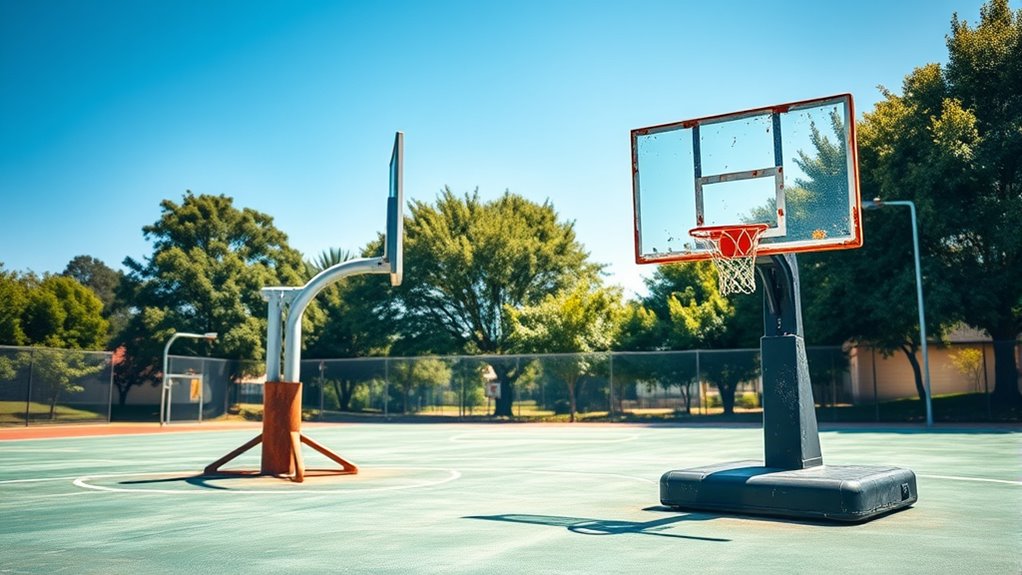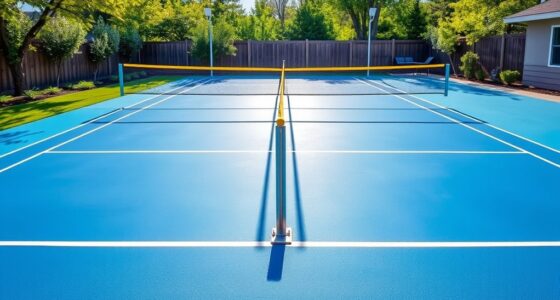Choosing between in-ground and portable outdoor basketball hoops depends on what you prioritize. In-ground hoops are fixed, offering exceptional stability and a professional feel, but they require professional installation and can’t be moved easily. Portable hoops are easier to set up, relocate, and are more budget-friendly, making them great for flexible use. If you want to learn more about which option might suit your needs best, keep exploring the differences.
Key Takeaways
- In-ground hoops offer superior stability and durability, ideal for long-term outdoor courts, while portable hoops provide flexibility and easy repositioning.
- Installation of in-ground systems requires professional setup with concrete, whereas portable hoops are DIY-friendly and quickly movable.
- In-ground hoops tend to be more expensive but offer less mobility, unlike portable options that are budget-friendly and easy to store.
- Both types can be placed on hard, level surfaces, but portable hoops can be used on various surfaces like concrete or asphalt.
- Portable hoops often have adjustable height mechanisms, making them suitable for casual play, while in-ground models provide more stable and precise adjustments.

Looking to set up an outdoor basketball hoop? You’ll want to weigh the benefits of in-ground versus portable options to find the best fit for your space and needs. In-ground hoops are cemented directly into the ground, providing exceptional stability and a permanent fixture for long-term use. They often come with height-adjustable poles, making it easy to customize the rim height for players of different ages and skill levels. Because these hoops are fixed, they tend to wobble less during play, offering a more consistent shooting experience. However, they require professional installation, including digging a solid foundation and pouring concrete, which can be costly and time-consuming. Once installed, they’re not easily moved, making them ideal if you plan to keep the setup in one spot for years.
In-ground hoops offer unmatched stability and permanence, ideal for long-term outdoor basketball setups.
On the other hand, portable hoops give you flexibility. They feature wheeled bases that can be filled with water or sand, providing stability while allowing you to move the hoop around as needed. The base capacity, usually between 27 to 42 gallons, influences how sturdy the system feels—larger bases keep the hoop steadier during aggressive play. Portable options are great if you want to switch locations, whether to store the hoop indoors during bad weather or to rearrange your driveway or backyard. They’re typically easier to set up, requiring no professional help, which makes them more budget-friendly and accessible for DIY installation. You can place them on various surfaces like concrete or asphalt, but a level, hard surface ensures the hoop remains stable and safe during use. For added safety and stability, some models include weather-resistant features that help withstand outdoor conditions over time.
When choosing a backboard material, consider tempered glass for the best rebound and a professional feel, or acrylic for durability and clear viewing. Polycarbonate is the strongest and shatterproof option, suitable for casual or beginner play, but it offers less bounce. Both in-ground and portable hoops often come with adjustable height settings, usually ranging from 7.5 to 10 feet, supporting players of all ages and skill levels. Some portable models use manual or crank mechanisms for height changes, while in-ground systems often feature more stable adjustments. The size and shape of the backboard can significantly impact gameplay, with regulation-sized rectangular boards providing a more authentic experience. Your decision should factor in space, budget, and how permanent you want the setup to be. If you’re committed to a long-term court, in-ground provides top stability and performance. If you need flexibility or want to avoid costly installation, a portable hoop offers convenience and adaptability. Either way, selecting the right type helps you enjoy basketball right in your own backyard, tailored to your lifestyle and needs.
Frequently Asked Questions
How Long Does It Take to Install an In-Ground Basketball Hoop?
Installing an in-ground basketball hoop typically takes about 5 to 10 days from start to finish. You spend initial days preparing the site, calling utility companies, gathering tools, and scheduling contractors if needed. The active installation, including digging, pouring concrete, and setting the hoop, usually takes 1-2 hours. The curing process lasts 2-7 days, after which you assemble and test the hoop, completing the installation.
Are Portable Hoops Suitable for Professional-Level Play?
You might wonder if portable hoops suit professional-level play. They can, thanks to features like adjustable heights, durable materials, regulation compliance, and high-quality backboards. Plus, their stability with weighted bases and safety features like breakaway rims make them viable. While they’re easier to set up and move, they still deliver the performance needed for serious practice or training, making them a flexible option for professional-level use.
What Maintenance Is Required for In-Ground Basketball Systems?
You need to regularly inspect, clean, weatherproof, repair, and replace parts of your in-ground basketball system. Check bolts and backboard mounts to prevent wobbling, clean surfaces to remove dirt, and apply rust-resistant coatings to protect against corrosion. Remove debris, snow, and ice, and touch up chipped paint. Replace worn nets, bent poles, or damaged hardware promptly, ensuring safety and performance stay exemplary for years to come.
Can Portable Hoops Withstand Harsh Weather Conditions?
You wonder if portable hoops can handle harsh weather. They do better with weather-resistant features like powder-coated steel poles and shatterproof backboards, but they’re still more vulnerable than in-ground models. Heavy bases filled with sand improve stability, yet strong winds and storms can cause tipping or wear over time. Regular maintenance, such as tightening bolts and protecting moving parts, helps extend their lifespan, but they generally need more care in severe conditions.
Which Type of Hoop Is More Cost-Effective Long-Term?
You’re wondering which hoop saves you money long-term. In-ground hoops may cost more upfront, but their durability and stability often mean fewer repairs and replacements over time. Portable hoops are cheaper initially, but they tend to wear out faster, requiring more frequent maintenance and replacements. If you play regularly or want lasting value, investing in an in-ground hoop saves you money in the long run, offering better performance and safety.
Conclusion
So, whether you choose an in-ground or portable hoop, remember that both will inevitably turn your driveway into a basketball battlefield. Sure, in-ground hoops seem permanent, but they’re a nightmare to move—kind of like that one ex you can’t forget. Portable hoops promise flexibility, yet somehow always find a way to wobble at the worst moment. Either way, get ready for endless games, and maybe a few missed shots—because that’s just part of the fun.









